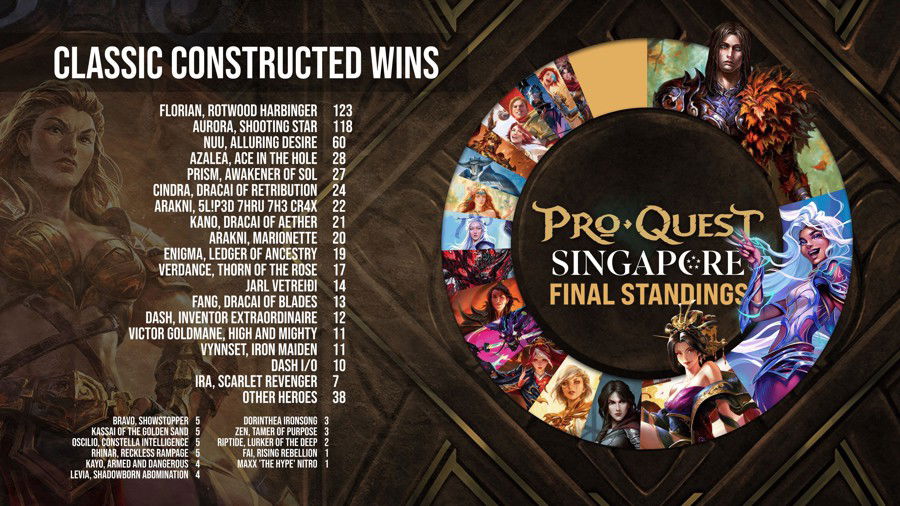Introduction
This past Monday, May 19th, 2025, LSS announced a big update to their banned and restricted list in light of what happened recently at some Pro Quest events. Namely, they changed all Flesh and Blood formats and the Living Legends system.
Here are the main changes:
Classic Constructed:
- Count Your Blessings (1) is banned;
- Germinate is banned;
- Scepter of Pain is banned;
- Bonds of Ancestry (1) (the red version) is unbanned.
Ad
Blitz:
- Channel Lightning Valley is banned;
- Count Your Blessings (1) is banned;
- Flicker Wisp is banned;
- Storm Striders is banned;
Living Legend:
- Carrion Husk is banned;
- Crown of Seeds is banned;
Ad
- Cull is restricted;
- Deadwood Dirge (1) is restricted;
- Succumb to Temptation is restricted;
- Hypothermia is no longer restricted.
Commoner:
- Reality Refractor is banned.
Classic Constructed

Ad
In our last article, in which we discussed Aurora's fast rise to the top, I mentioned how Florian was starting to become dangerous to the meta.
He was not only clearly the best deck in the format by far (as the results below, compiled at the end of this Pro Quest season, show), but was also heading towards the same path Aurora was. The LSS needed to ban something to avoid the same situation repeating itself, and they decided to ban Scepter of Pain and his specialization, Germinate.


We can compare Scepter of Pain, to a certain point, with Kraken's Aethervein, a Wizard weapon, as they're both extremely strong with the Amp mechanic. Fortunately, Kraken never really got to coexist with Amp in Classic Constructed (we can't say the same for Living Legend, though). However, though Florian had to use it in a much more restricted way, he was using it beautifully.
Thanks to his flexibility and Channel the Millennium Tree, Florian could set up OTKs that created countless Runechants, and forcing your opponent to play enough Arcane protection to stop Scepter was just too much. So, it was banned.
With it, LSS banned Germinate too for two reasons: the first one is that you didn't have to build a certain type of deck to play this specialization and, yet, it would always win extremely long matches for you, and the second is because the next set, High Seas, will give us a new card that would be devastating with it (we still don't know what this card is). So, by banning it, LSS is making sure these two cards never see play at the same time.

Ad
Well, here we are again talking about Count Your Blessings (1) (or CYB). Last year, in November, the blue version of this instant was banned because of its strong interaction with heroes that cared about blue cards and could be hard control, like Enigma, Ledger of Ancestry and Nuu, Alluring Desire. However, CYB proved to be quite problematic, not on a competitive level, but in casual Armory settings. Games would take too long, and players with decks that were vulnerable to this strategy were getting too frustrated.
Furthermore, heroes were taking CYB to the limit: whenever a new defensive tool came out, CYB was thrown beside it. This was quite a headache for the design team, which had to figure out a way to develop new cards without players creating a new deck that made matches last over 50 minutes. As a result, CYB was removed both from Classic Constructed and Blitz.
However, that's not the only card that will give you déjà vu today.

Back at the iconic "Book Burning", one of the most important banned and restricted announcements in the history of the game, Bonds of Ancestry (1) was banned because of what Zen, Tamer of Purpose was doing to the format.
However, now Zen is a Living Legend and Katsu, the Wanderer needs some support to be competitive again. That's why this attack has returned to the format (just one of its versions, though): to give this Ninja some support without creating other problems.
Blitz

Ad
Also in our last article, when we discussed Aurora, I mentioned that, if LSS didn't do something to Blitz, she would be headed down the same path she walked in Classic Constructed. Well, they did something, alright.
In a format with less life, Flicker Wisp and Arc Lightning enabled absurd turns that overcame even the most defensive decks. Furthermore, Channel Lightning Valley not only gave Aurora an extra card, and, as such, made her incredibly powerful, but also helped her deal more damage overall.
Removing these cards will both help defensive decks fight Aurora and give Aurora weaknesses other decks will be able to explore.

A few years ago, Storm Striders was banned in Blitz, and, to help Kano, who was relatively weak, it was unbanned later on. Ever since then, this Legs equipment is in the format - and what happened during all this time?

Wizards stayed at the top of the meta. Because in this format heroes have less life, Storm Striders threatened lethal damage really early on, and on the opponent's turn. To make things worse, each Wizard could play a Non-Attack Action at "instant" time in their own way to find lethal plays.
After all these years, clearly this class got a lot of value from Storm Striders. So, to pull Blaze and Verdance back a bit, LSS decided to ban this equipment.
Ad
Living Legend
Before we discuss the format that changed the most today, let's give Living Legend some special attention. From now on, Living Legend is considered a competitive format, which means it will be part of the World's competitive circuit (alongside Draft and Classic Constructed), and will be featured in more Rated events (like Pro Quest, for instance). As a result, it will be changed more often from now on.

Bravo (or Starvo) and Chane have been the best decks in the format for a while now. Events like Skirmishes and even at the Battle Hardened: London have shown us they're still at the very top of the format.

Though their abilities are what makes them so strong, a few other cards that stay in play with them are also part of it. While Crown of Seeds lets Starvo be extremely defensive (even more with Fyendal's Spring Tunic) and doesn't punish you for putting bad cards in your arsenal, banning Carrion Husk is supposed to fix another problem Chane has: being good at everything.

With Husk, Chane could hold off disruptive attacks. Cull and Succumb to Temptation let him disrupt the opponent quite heavily, and Deadwood Dirge (1) is an excellent aggressive option (particularly with Soul Shackle). So, LSS decided to ban this equipment and make the other cards restricted.
Ad

Lastly, they made Hypothermia unrestricted to give Ice decks (particularly Iyslander, Stormbind) a disruptive tool, considering Starvo and Chane are more contained now.
Commoner

In the last banned and restricted update, Zephyr Needle, Rosetta Thorn, and Waning Moon were banned because they were too strong for Commoner, but Reality Refractor was kept in the format because it needed more time to work. However, once it did, it made matches very problematic for the opponent. So, LSS decided to ban it.
Changes to the Living Legend System
In LSS's last Dev Talk episode, they mentioned they would introduce some changes to prevent new heroes from stacking up points too fast, and that came today. They made two significant changes:
- Living Legend points can be something like 2.75 at a certain event, and;
Ad
- Living Legend points will be subject to multipliers that scale over a hero’s lifespan.
The first change is supposed to prevent heroes from getting too many points overall. So far, if a hero got 2.51 points, for instance, it would be rounded up, and they'd get 3 points instead. It doesn't seem like a lot, but, when you combine the several events going on at all times and how often this happened, it's clear heroes were getting way more points than they should.
The second change has a clear goal: prevent what happened with Aurora from ever happening again. The Living Legend system will now work with the following multipliers:
- Heroes that have been around for less than a year get half the points (x 0.5);
- Heroes that have been around for at least a year get the regular number of points (x1);
- Heroes that have been around for two or more years get x1.5 as many points.
Example: let's assume a certain hero won Worlds (which, currently, gives out 100 points). In the old system, any hero would get 100 points, but, in the new system, this is how many points they'll get:
- Heroes with less than a year: 50 points;
Ad
- Heroes with at least a year: 100 points;
- Heroes with at least two years: 150 points.
LSS also stated that they'll monitor this change and that they can adjust it.
Final Words
Usually, this is when we would discuss how the changes will affect the meta, but the new set is so close (just two weeks away) that I'm sure the meta will change again then, and will be entirely different at Nationals. So, stay tuned for our High Seas review in the next few days.
After reviewing the entire announcement, I can say LSS was really concerned with what Aurora did to the game. The changes they made to all formats were not only extensive, but also severe (we saw what happened with Chane in Living Legend, Aurora in Blitz, and Florian in Classic Constructed), and will probably prevent heroes from dominating the formats. Furthermore, the change to the Living Legend system will make us feel safer whenever we want to build new decks for new heroes, and discourages us from sticking to the same old archetypes. With time, we'll see if these changes make the game better or worse.
What did you think of this announcement? Tell us your thoughts in our comment section below.
Thank you for reading, and see you next time!
Ad







— Commenti
0Diventa il primo a commentare